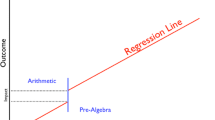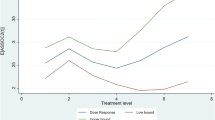Abstract
The impact of academic programs—such as developmental mathematics programs—on student retention, has been a controversial topic for administrators, policy makers, and faculty in higher education. Despite deep interest in the effectiveness of these programs in retaining students, scholars have been unable to determine whether such programs have a causal impact on student retention. Rather than assigning students to a developmental program based on a random assignment process as in a true experiment, most of the existing research up to this point has been non-experimental and has focused exclusively on whether student background and demographic characteristics are statistically significant predictors of dropout. Furthermore, prior research is also limited by its reliance on cross-sectional, retrospective designs despite the longitudinal nature of the dropout phenomenon. In this paper, I report the results of a unique piece of research which embeds a regression-discontinuity design within the framework provided by discrete-time survival analysis. By combining these two approaches, I was able to obtain an unbiased estimate of the causal impact of participating in a developmental program in mathematics, and confirm that the risk of leaving college among students who participate in developmental mathematics programs was significantly lower than for equivalent students who did not participate in such programs.



Similar content being viewed by others
References
Adelman C. (1999). Answers in the Tool Box: Academic Intensity, Attendance Patterns, and Bachelor’s Degree Attainment. U.S. Department of Education, Jessup, MD
Altieri G. (1990). A structural model for student outcomes: Assessment programs in community colleges. Community College Review 17(4): 15–32
Angrist J., Krueger A. (1991). Does compulsory school attendance affect schooling and earnings?. Quarterly Journal of Economics 106: 979–1014
Baxter J., Smith S. (1998). Subsequent grades assessment of pedagogies in remedial mathematics. Primus 8(3): 276–288
Berk R., DeLeeuw J. (1999). An evaluation of California’s inmate classification system using a generalized regression discontinuity design. Journal of the American Statistical Association 94(448): 1045–1052
Berk R., Rauma D. (1983). Capitalizing on nonrandom assignment to treatments: A regression-discontinuity evaluation of a crime-control program. Journal of the American Statistical Association, 78(381): 21–27
Black S. (1999). Do better schools matter? Parental valuation of elementary education. Quarterly Journal of Economics 114: 577–599
Boylan H., Bonham B., White S. (1999). Developmental and remedial education in post secondary education. New Directions for Higher Education 108: 87–101
Brooks-Leonard C. (1991). Demographic and academic factors associated with first-to-second-term retention in a two-year college. Community/Junior College 15: 57–69
Burley H., Butner B., Cejda B. (2001). Dropout and stopout patterns among developmental education students in Texas community colleges. Community College Journal of Research & Practice 25: 767–782
Cloud J. (2002). Who’s ready for college. Time 160(16): 60–61
Cook J., Campbell D. (1979). Quasi-Experimentation. Rand-McNally, New York, NY
Cross K. (1976). Accent on Learning: Improving Instruction and Reshaping the Curriculum. Jossey-Bass, San Francisco, CA
Feldman M. (1993). Factors associated with one-year retention in a community college. Research in Higher Education 34(4): 503–512
Grimes S. (1997). Underprepared community college students: Characteristics, persistence, and academic success. Community College Journal of Research & Practice 21(1): 47–56
Grubb W., Worthen H. (1999). Remedial/developmental education: The best and the worst. In: Grubb W (eds), Honored but Invisible: An Inside Look at Teaching in Community Colleges. Routledge, New York, NY
Hardin C. (1998). Who belongs in college: A second look. In: Higbee J. L., Dwinell P. L. (eds), Developmental Education: Preparing Successful College Students. National Resource Center for the First-Year Experience of Students in Transition. University of South Carolina, Columbia, SC, pp. 15–24
Hector, J., and Hector, M. (1992). Impact of state-mandated developmental studies on college student retention. Paper presented at the Annual meeting of the American Educational Research Association, San Francisco, CA, ERIC ED 345 600
Hosmer D., Lemeshow S. (2000). Applied Logistic Regression. (2nd Ed.) Wiley, New York, NY
Hoyt J. (1999). Remedial education and student attrition. Community College Review 27(2): 51–72
Imbens G., VanDerKlaauw W. (1995). Evaluating the cost of conscription in the Netherlands. Journal of Business Economics and Statistics 13: 207–215
Judd C., Kenny D. (1981). Estimating the Effects of Social Interventions. Cambridge University Press, London, England
Kull K. (1999). A developmental education survey: Results of a national survey of program design and mathematical instruction. Research and Teaching in Developmental Education 16(1): 57–80
Lazarick, L. (1997). Back to the basics: Remedial education. Community College Journal 11–15
Leuven E., Lindahl M., Oosterbeek H., Webbink D. (2004). The Effect of Extra Funding for Disadvantaged Pupils on Achievement. The Institute for the Study of Labor Discussion Paper No. 1122, Bonn, Germany
Morante E. (1989). Selecting tests and placing students. Journal of Developmental Education 13(2): 2–6
National Center for Educational Statistics. (2001). Remediation and Degree Completion. U.S. Department of Education
Pettersson-Lidbom P. (2003). Do Parties Matter for Fiscal Policy Choices? A Regression-Discontinuity Approach. Stockholm University, Stockholm, Sweden
Reichardt C., Trochim W., Cappelleri J. (1995). Reports of the death of regression-discontinuity analysis are greatly exaggerated. Evaluation Review 19(1): 39–63
Roueche J., Baker G., Roueche S. (1985). Access with excellence: Toward academic success in college. Community College Review 12(4): 4–9
Roueche J., Roueche S. (1999). High Stakes, High Performance: Making Remediation Work. American Association of Community Colleges, Washington, DC
Rubin D. (1977). Assignment to treatment group on the basis of a covariate. Journal of Educational Statistics 2(1): 1–26
Shadish W., Cook T., Campbell D. (2002). Experimental and Quasi-experimental Designs for Generalized Causal Inference. Houghton Mifflin, Boston, MA
Simonoff J. (1997). Smoothing Methods in Statistics. Springer-Verlag, New York, NY
Sinclair Community College. (1994). The impact of developmental education on student progress: A three year longitudinal analysis. Office of Institutional Planning and Research, Sinclair Community College, ERIC ED 383 382, Dayton, OH
Singer J., Willett J. (2003). Applied Longitudinal Data Analysis: Modeling Change and Event Occurrence. Oxford University Press, New York, NY
STATA Corporation. (2003). STATA Base Reference Manual. (Vol. 1) STATA Press, College Station. TX
The Institute for Higher Education. (December 1998). College remediation: What it is. What it costs. What’s at stake. Washington, DC
Thistlethwaite D., Campbell D. (1960). Regression-discontinuity analysis: An alternative to the ex post facto experiment. Journal of Educational Psychology 51: 309–317
Tinto V. (1996). Restructuring the first year of college. Planning for Higher Education 25: 1–6
Trochim W. (1984). Research Design for Program Evaluation: The Regression -Discontinuity Approach. Sage, Newbury Park, CA
vanDerKlaauw W. (2002). Estimating the effect of financial aid offers on college enrollment: A regression-discontinuity approach. International Economic Review 43(4): 1249–1287
Waycaster P. (2001). Factors impacting success in community college developmental mathematics courses and subsequent courses. Community College Journal of Research & Practice 25: 403–416
Wooldridge J. (2003). Introductory Econometrics: A Modern Approach. (2nd Ed.) South-Western, Mason, Ohio
Author information
Authors and Affiliations
Corresponding author
Rights and permissions
About this article
Cite this article
Lesik, S.A. Do developmental mathematics programs have a causal impact on student retention? An application of discrete-time survival and regression-discontinuity analysis. Res High Educ 48, 583–608 (2007). https://doi.org/10.1007/s11162-006-9036-1
Received:
Accepted:
Published:
Issue Date:
DOI: https://doi.org/10.1007/s11162-006-9036-1




